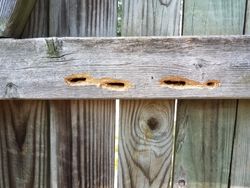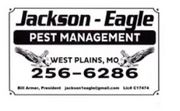
Bees are widely considered beneficial insects, as their pollination is vital to agriculture and food production. However, one species of bee can be harmful to your home if left unchecked. Carpenter bees are a species of bee that don't live in hives. These solitary insects build tunnels and nests inside wood. Because this can weaken the structures of your home, pest control measures are necessary as soon as you spot signs of an infestation.
Identifying Carpenter Bees
Carpenter bees are very similar to bumblebees. However, instead of a furry body, the top part of their abdomens are bare and shiny. Most carpenter bees do not have the yellow stripes of other species either.
Only the females have stingers, but they are generally not aggressive, and they rarely sting. Males are very aggressive and territorial, but they don’t have stingers. They will likely fly toward you if you get too close to their home, but since they cannot sting, they’re more of a nuisance than a danger.
Carpenter Bee Behavior
Carpenter bees got their name because they bore holes into wood to create their homes. Females do the work and will bore a circle several inches into wood. These tunnels are about a half-inch in diameter and will turn at 90 degrees, following the length of the wood.
A single bee can make several different tunnels from the same hole. Within each tunnel, the bee creates partitions using the wood chips left behind as she dug the tunnel. Each partition holds a single egg and food to support the developing larvae.
Carpenter bees may reuse the same tunnel complex for generations. The life cycle of carpenter bees is one year, and they hibernate inside the wood during the winter. However, when young bees are born in the late summer, they typically return to their birthplace.
Early pest control is important for these creatures. Unless their tunnels are blocked, they’ll keep coming back and creating new ones, causing serious property damage.
Signs of an Infestation
 The clearest sign of an infestation is the appearance of small holes in wood around your home, including decking, trim, wooden fencing, wood siding and doors, sheds, and porch ceilings. These bees prefer unpainted or untreated wood that’s at least two inches thick.
The clearest sign of an infestation is the appearance of small holes in wood around your home, including decking, trim, wooden fencing, wood siding and doors, sheds, and porch ceilings. These bees prefer unpainted or untreated wood that’s at least two inches thick.
Painting and staining wood can help keep these pests at bay. Filling in any holes you discover can also prevent damage. Pest control treatments are most effective in the spring before the bees mate and lay eggs, and in the fall, in case any eggs matured.
If you spot signs of a carpenter bee infestation, trust Jackson & Eagle Pest Management in West Plains, MO, to solve the problem. Serving the Ozarks region for almost 60 years, their team of experts specializes in pest control, including bees, ants, rodents, roaches, fleas, and spiders. Call (417) 256-6286 for a free estimate, and visit their website to learn more information about their services.
About the Business
Have a question? Ask the experts!
Send your question

